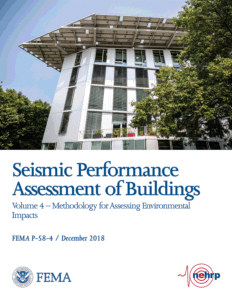Forschungszweck:
Entwicklung einer umfassenden Datenbank zur Reparatur von strukturellen und nicht strukturellen Bauteilen.
Über
Bei der Bewertung der Lebenszyklus-Umweltauswirkungen von Gebäuden, the contributions of seismic damage are rarely considered. This project developed and analyzed the largest known environmental impact database of building component seismic damage. By extending established methods of probabilistic seismic performance evaluation to include environmental impacts, a more comprehensive assessment of a building’s expected seismic performance can be evaluated.
To calculate the environmental impacts, data from Carnegie Mellon University’s Green Design Institute’s Economic Input-Output Life Cycle Analysis (LCA) database were connected to previously established repair cost estimate data. Environmental impacts, including embodied carbon, embodied energy, and other metrics, were calculated for the repair of nearly 800 building components under three or more different seismic damage levels. This database was developed to support the Federal Emergency Management Agency’s (FEMA) Performance Assessment Calculation Tool (PACT) as a part of FEMA-Projekt P-58.
Ergebnisse
Umweltverträglichkeitsprüfung für FEMA P-58 kann gefunden werden in:
- FEMA-P-58-4: „Band 4 - Methodik zur Bewertung der Umweltauswirkungen“
- Hintergrunddokumentation, Abschnitt 3.7.20: „Methodik zur Umweltverträglichkeitsprüfung“ (zip-Datei)
Zeitschriftenpublikationen
- Simonen, Huang, Aicher & Morris. (2018). Verkörperter Kohlenstoff als Proxy für die Umweltauswirkungen der Reparatur von Erdbebenschäden. Energie & Gebäude.
- Huang & Simonen. (2020). Vergleichende Umweltanalyse von Erdbebenschäden in Gebäuden. Zeitschrift für Tragwerksplanung.
Forschungsgruppe
- K. Simonen (UW), PI
- M. Huang (UW)
- P. Morris (AECOM)
Danksagung
Dieses Material basiert auf Arbeiten, die von der Federal Emergency Management Agency finanziert und vom Applied Technology Council (ATC) im Rahmen des ATC 58-2-Projekts verwaltet werden, dessen Inhalt der Öffentlichkeit gewidmet ist. Alle im Material geäußerten Meinungen, Ergebnisse und Schlussfolgerungen oder Empfehlungen sind die der Autoren und spiegeln nicht unbedingt die Ansichten der Federal Emergency Management Agency oder des Applied Technology Council wider.
Additional contributions from John Hooper, Anthony Court, Wayne Trusty, Mark Webster, and Jon Heinz. We thank Chris Aicher and Professor Paul Sampson from the Department of Statistics at the University of Washington for their assistance and advisement in the statistical component of this work. We also thank Ibrahim Almufti, his team at ARUP, and Kristen Strobel, a graduate student at the University of Washington, for their work in providing the data for the case study building as well as H. Scott Matthews at Carnegie Mellon University for his advice regarding the use of their EIO LCA database.
We would also like to acknowledge John Gillengerten, who developed the PACT model files for the case study buildings and provided guidance on their use; Vesna Terzic, who evaluated the case study buildings during their development; Scott Hagie and Russell Larson, who provided additional support for the PACT software; and Ayse Hortacsu for additional information about PACT.
